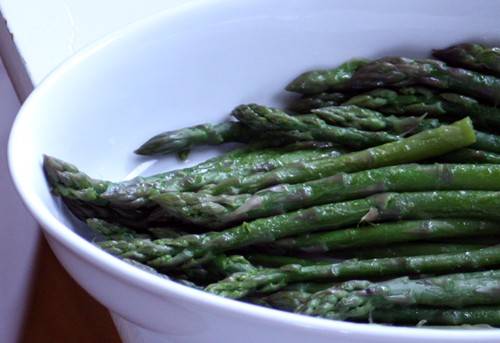 The asparagus patch is in full production, and we get a good sized bunch about every other day – sometimes everyday if we’ve had rain and then some warm temperatures.
The asparagus patch is in full production, and we get a good sized bunch about every other day – sometimes everyday if we’ve had rain and then some warm temperatures.
In the past, I’ve always sauteed or steamed my asparagus. Steaming is nice, but unless you have one of those tall, narrow pots just for steaming asparagus (which I don’t), it is difficult to get the entire spear done at the same degree of tenderness. Sauteeing is ok, but I don’t like to cook it this way everytime – it’s a little heavy.
So, enter Vegetable Goddess Deborah Madison – author of Vegetarian Cooking for Everyone. I’ve praised this book before, primarily because it has a small section for almost every vegetable you might feel the need to cook.
Her recommended method is simple, and if well-timed, yields perfect asparagus in its simplest cooked form. Here are the directions: Bring a few inches of water in a large skillet to a low boil. Put in similarly sized asparagus, with the tips all pointing the same direction. Boil for 6-10 minutes, depending upon thickness. Remove from water, pat dry, and dress however you’d like.
The only way to mess this up is to let it cook too long. You want to be able to pierce the asparagus with a fork, but you don’t want it to be soft and floppy. Typically, its ready shortly after it turns bright green.
I like to just use a bit of butter and salt on it, but lemon juice is nice too, or a little vinaigrette, or some garlic-spiked mayonnaise for dipping.
Other asparagus tips: if you’re not getting it from your garden, or a nice friend’s garden, get it from a farmer’s market. Asparagus is best used shortly after being picked. Thick stalks are not older or woodier than thin stalks – in fact, some folks think they have more flavor. Store them upright in a glass with some water in the fridge (like flowers in a vase) until ready to use. Snap them by hand before using – they will naturally snap in the right place, allowing you to discard the more fibrous end.
Enjoy – the season is short!



